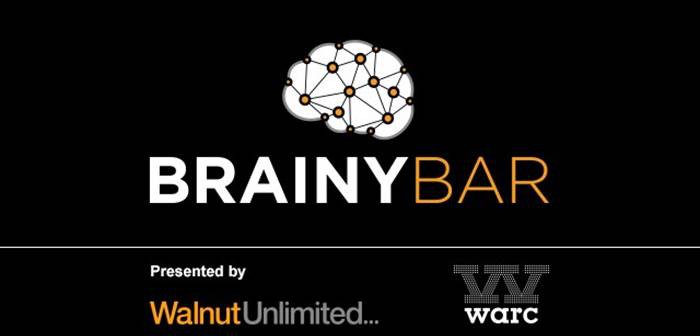The 22nd of February marked the much anticipated second instalment of Brainy Bar, a series of events run by Walnut Unlimited and Warc where the applications and future of neuroscience are discussed.
The evening kicked off with Oxford University’s Prof. Charles Spence discussing the rise of ‘gastroporn’ and what brands can learn about the impact of images and implicit cues in our environments on how food is perceived.
We eat first with our eyes
Prof. Spence emphatically referenced that willingness to pay for a certain dish increases with the quality of presentation – in other words, plating for the eye will enhance value. Among others, this was verified by a study run in his lab where a range of people were given a plate of salad that was arranged like an abstract painting (Kandinsky Painting No201), whereas others were given the same ingredients but arranged as a pile of salad. The Kandinsky salad was not only rated the best, but also as more valuable – the subjects were willing to pay twice as much both before and after eating it. Unsurprisingly, the Press (see Mail Online and Guardian articles) picked up on the study fairly quickly.
Freshness and appeal are perceived from implied motion
In two separate studies, researchers found that implied motion elevates consumers’ food quality evaluation in terms of freshness and appeal, therefore also potentially augmenting the consumption experience. Selling orange juice? Make sure your ads feature imagery of the product being poured onto a glass then. Furthermore, because the brain simulates the act of eating, the easier it is to imagine consumption of a certain product, the bigger the connection we will make to the brand advertising it; if you’re trying to sell cake, say in a Print ad, you might want to consider carefully whether the spoon should be placed on the left or right hand side of the product.
What’s also interesting about this piece of research, he mentioned, is that is suggests that leveraging this insight could be used to encourage the uptake of healthier food choices – whether or not that’s ethical is a discussion for another forum.
Dr Andy Meyers from Walnut Unlimited was up next discussing the value of using implicit testing, in addition to explicit, to better understand human behaviour. Why? Because people don’t always say what’s on their minds.
You don’t want people to think, you want people to do
Kahneman’s system 1 (unconscious) and 2 (conscious) were referenced from the onset to illustrate that it is the link between both that influences the decisions we make. However, the way brands are perceived in the brain are much more complicated than what marketers believe and what often seems like a rational and pondered system 2 decision often has long been decided by the fast and automatic system 1 – hence the need to build what he called effortless brands.
Explicit vs Implicit measurement
Dr Meyers argued that in order to gain a deeper understanding of people’s motivations it’s important to measure consumer attitudes with implicit testing techniques, often involving brain imagery, such as EEG or fMRI. He drew on empirical research from the political sphere to show what kind of messages different candidates should have pushed for in their campaigns, but it was the NRK (equivalent of BBC in Norway) example that captured our attention. As a business, they aimed to drive a connection with young adults. Different survey techniques consistently demonstrated that soft metrics such as NRK is a brand for me, is a brand that understands my needs, is a modern broadcaster scored highly. These were the type of messages they were pushing in their communications so life was apparently good. However, viewership continued on a downward trajectory. It was not until implicit measurement techniques were employed that they found that the quality and type of the content was deemed to be completely inadequate and not relevant to what young adults wanted to watch. As a marketer, you should be aware of potential pitfalls of surveys as an explicit measurement technique, especially when the results don’t translate into how your brand is performing in market.
Last but not least, was the unmistakable Rory Sutherland on the science of knowing what economists are wrong about; or framed differently on the truths about the way we really make decisions. As one of the strongest advocates for practical behavioural economics (BE), Rory offered a number of scenarios that showcase the truths about the way we really make decisions, which the reader familiar with his famous TED and YouTube videos will recognise.
Choosing is relative to what you can have, not absolutely about what you want
He flirted with one of the pillars of BE ‘choice architecture’, the notion that the ways choices are presented to people unmistakably influences the outcome of our decisions. He made reference to a brilliant example of an airline company: by simply reducing the number of flight destinations on sale from 29 to five, the initiative sold out for the first time in 15 years.
Behaviour of decision makers under circumstances in which an optimal solution cannot be determined – mostly always
A cognitive heuristic that received some emphasis was the concept of satisficing: avoiding catastrophe is unconsciously more important to people than achieving perfection. To illustrate this feature of animal – not just human – evolution he showcased the hilarious video of cats being scared of cucumbers. He argued that cats that approached the situation differently in the past, with curiosity as opposed to the automatic flight response, have long been lost in the evolutionary chain. Satisficing is a prominent feature of people’s decision making process that marketers often ignore – sometimes it’s better to remove any negatives, any barriers to entry, than simple adding or highlighting positives.
All in all, it was a hugely entertaining and thought-provoking event. We cannot wait for the next instalment!




